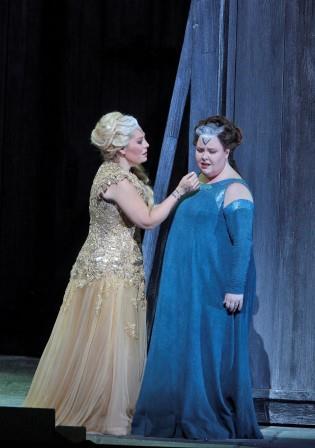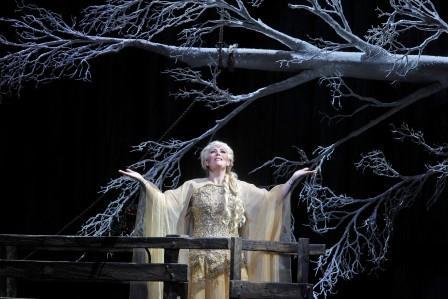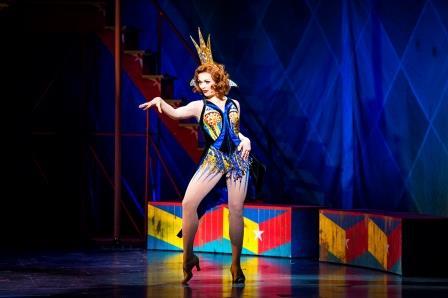Every now and then when I'm searching for a theme to write about, I find inspiration in a most unusual source: serendipitous calendaring. Even though I might not have imagined any possible kind of idea that could connect two performances I'm scheduled to attend on consecutive nights, something happens after the house lights go down that leaves me positively gobsmacked.
Often, the connection is something that could never have been imagined on paper or in theory. It's only after the curtain rises that cognitive links begin to emerge. A recent example (which involved two legendary pieces of musical theatre) was particularly breathtaking.
- Both works have clearly stood the test of time -- one is an opera that had its world premiere on December 26, 1831 at Teatro alla Scala in Milan; the other is a popular Broadway musical that premiered on October 23, 1972.
- Both works have been identified as classics of their particular genre -- Vincenzo Bellini's opera is a cornerstone of the bel canto repertoire; Stephen Schwartz's musical is often cited as the definitive showcase for Bob Fosse's artistic vision as a stage director and choreographer with "Magic To Do."
- Both works make important historical references to the political power of Rome: in the opera, Pollione is a proconsul of the Roman Republic stationed in Gaul who has been romantically involved with not one, but two Druid priestesses; one of the main characters in the musical (Charlemagne) was crowned as Holy Roman Emperor by Pope Leo III in 800.
A 10th century copy of a tapestry from approximately 830
showing King Charlemagne with Pippin the Hunchback
(Photo courtesy of Wikimedia Commons)
- Both works contain surprisingly strong anti-war messages in their narratives.
- Both works went on to become key successes in their composer's catalog.
- Both works require performers who have mastered an extraordinary set of acrobatic skills: one vocal, the other a combination of dance and gymnastics.
- Both works require artists who are confident in their stamina as vocal or physical athletes.
- Both works can be severely impacted by the acoustics of any particular performance (one relies on singers using their diaphragms for breath control to "float" a beautiful musical line; the other depends heavily on electronic amplification whose ability to distort sound can result in the kind of shrillness that compromises the overall quality of a performance).
- Both works require safe displays of fire onstage.
Who knew?
* * * * * * * * * *
In an era when few people are accustomed to hearing singers whose voices have not been manipulated by sound engineers, the San Francisco Opera's new production of Norma offered a stunning display of great singing. Not only were the three principals extremely capable artists who could deliver some wonderful vocal shading, their voices were easily able to fill a 3,000-seat auditorium without the help of amplification. These artists had an astonishing ability to maintain impressive volumes of sound (without showing vocal strain) over the course of a three-hour performance.
Sondra Radvanovsky and Jamie Barton in Bellini's Norma
(Photo by: Cory Weaver)
By a curious twist of fate, Jamie Barton (Adalgisa) and Russell Thomas (Pollione) were last-minute replacements for the artists who had originally been signed for their roles. With solid support from conductor Nicola Luisotti, they easily fit into Kevin Newbury's new co-production with the Lyric Opera of Chicago, the Canadian Opera Company, and the Gran Teatro del Liceu in Barcelona.
I was especially taken with David Korins's heavily wood-themed unit set which depicts the inside of a huge barn-like structure being used by a tribe of Druids as a combination shelter and factory for building a war machine with which to fight the Romans. Jessica Jahn's costumes added a half-primitive, somewhat symbolic touch to the proceedings
Sondra Radvanovsky stars in Bellini's Norma
(Photo by: Cory Weaver)
Of course, one doesn't set out to produce Bellini's opera unless one has a specific soprano in mind who can handle the vocal demands of the role. Following her recent Metropolitan Opera triumph, Sondra Radvanovsky awed the audience with her powerfully dramatic portrayal of the titular Druid priestess. Whether tackling the monumentally difficult aria, "Casta Diva," or singing duets with Jamie Barton's lusciously-voiced Adalgisa, this was a night for the kind of grand singing that is rarely heard anymore.
The final moments of Bellini's Norma (Photo by: Cory Weaver)
A last-minute substitution for Pollione, young Russell Thomas demonstrated an impressive, powerful tenor with a strong sense of purpose. Minor roles were taken by Christian Van Horn (Oroveso), Jacqueline Piccolino (Clotilda), and A. J. Glueckert (Flavio). Special credit goes to D. M. Wood for her evocative lighting and chorus director Ian Robertson. Here' s some footage from the production.
* * * * * * * * * *
Inspired, no doubt, by her work directing Cirque du Soleil's 2012 production of Amaluna, Diane Paulus (the artistic director of the American Repertory Theater in Cambridge, Massachusetts), approached her revival of 1972's Pippin with a great deal of circus magic in mind. The illusions designed by Paul Kieve and circus acts devised by Gypsy Snider of Montreal's 7 doigts de la main circus troupe give a much more contemporary feeling to the commedia dell'arte players than was seen in the original Broadway production of Pippin.
That production, with its book by Roger O. Hirson, was conceived as a one-act, somewhat surreal piece of entertainment that was memorably enhanced by Fosse's thrilling choreography. Its costumes gave a definite sense of period and the production (for which Bob Fosse won the 1973 Tony Award for Best Direction of a Musical) worked hard to seduce its audience.
This revival of Pippin has been choreographed by Chet Walker "in the style of Bob Fosse." A veteran of many Fosse productions, Walker is keenly in touch with the kind of jazz hands, hat tricks, and angular hip movements used by Fosse beginning in 1954 with the"Steam Heat" number from The Pajama Game and on through Sweet Charity (1966), Chicago (1975), and Dancin' (1978).
What landed on the stage of the Golden Gate Theatre when the new national touring company of Pippin came to town was a perfect example of the kind of glitter and dazzle that can anesthetize an audience the way too much ice cream eaten too quickly can trigger a sensation of brain freeze.
In the four decades since Pippin premiered on Broadway, some of Schwartz's songs ("Magic To Do," "Corner of the Sky") have embedded themselves in the popular culture. However, I have a particular fondness for "Spread A Little Sunshine" as sung by Sabrina Harper's leggy Fastrada.
Sabrina Harper as Fastrada in Pippin (Photo by: Terry Shapiro)
John Rubenstein (who portrayed Pippin in the original Broadway cast and now appears as his father, Charlemagne) likens the revised version of the show to focusing on the character of Pippin as "a sort of reality-TV centerpiece." As Pippin's lusty grandmother, Berthe, Lucie Arnaz had a grand old time leading the audience in a sing-along of "No Time At All."
Much to my surprise, Matthew James Thomas (Pippin) and Kristine Reese (Catherine) seemed remarkably bland in their roles. Although Sasha Allen is a steely Leading Player, I found myself infinitely more entertained by Callan Berrgmann's performance as Pippin's slimy, scheming brother, Lewis.
Matthew James Thomas (Pippin) with Callan Bergmann (Lewis)
Over the years, Pippin has often been broken into two acts (which, in the case of Paulus's 2013 revival, means that a great deal of shtick has been ladled onto the stage in order to stretch things out). The revised ending, in which the character of Theo takes on the new quest for meaning and fulfillment, is ominously preceded by numerous statements by the Leading Player that "The show is over!" If only someone had made that clear to Ms. Paulus.
Clad mostly in a combination of acrobatic spandex, this revival's cast aims to clobber the audience into submission by dazzling them with circus stunts and deafening them with amplification. As someone who was never a rabid fan of the original production, I found it ironic to notice how this ardent young hero in search of a life that will bring him meaning and fulfillment is stopped at various points during the show and asked how he feels about his latest experience.
"Empty and vacant," replies Pippin. I would add "painfully shrill" to his description.
Curiously enough, three years after staging Pippin, Fosse (known for his salesmanship and cynicism) created the famous "Razzle Dazzle" number for Chicago. Audiences who see both shows (which have been touring simultaneously) will understand how the "Razzle Dazzle" number offers a perfect description of Pippin.
To read more of George Heymont go to My Cultural Landscape






